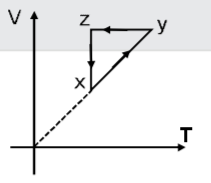Choose the correct alternative (a), (b), (c) or (d) for each of the questions given below :
For an adiabatic change of a perfect gas the relation between pressure and volume is :
PVγ=constant
PγV=constant
PV = constant
PVγ−1=constant
The correct Answer is:A
To solve the question regarding the relation between pressure and volume for an adiabatic change of a perfect gas, we can follow these steps:
Step 1: Understand the Adiabatic Process
In an adiabatic process, there is no heat exchange with the surroundings. Therefore, the first law of thermodynamics simplifies to:
ΔU=W
where ΔU is the change in internal energy and W is the work done on or by the gas.
Step 2: Use the Ideal Gas Law
For a perfect gas, the ideal gas law is given by:
PV=nRT
where P is pressure, V is volume, n is the number of moles, R is the universal gas constant, and T is the temperature in Kelvin.
Step 3: Apply the Adiabatic Condition
For an adiabatic process involving a perfect gas, the following relationships hold:
1. PVγ=constant
2. TVγ−1=constant
Here, γ (gamma) is the heat capacity ratio defined as:
γ=CpCv
where Cp is the heat capacity at constant pressure and Cv is the heat capacity at constant volume.
Step 4: Identify the Correct Relation
From the relationships stated above, the correct relation for pressure and volume during an adiabatic change is:
PVγ=constant
Step 5: Choose the Correct Option
Now, we can analyze the options provided in the question. The correct relation is represented by:
- Option (a): PVγ=constant (This is correct)
- Option (b): Incorrect
- Option (c): Incorrect
- Option (d): Incorrect
Thus, the correct answer is option (a).
In an adiabatic process, there is no heat exchange with the surroundings. Therefore, the first law of thermodynamics simplifies to:
ΔU=W
where ΔU is the change in internal energy and W is the work done on or by the gas.
For a perfect gas, the ideal gas law is given by:
PV=nRT
where P is pressure, V is volume, n is the number of moles, R is the universal gas constant, and T is the temperature in Kelvin.
For an adiabatic process involving a perfect gas, the following relationships hold:
1. PVγ=constant
2. TVγ−1=constant
γ=CpCv
where Cp is the heat capacity at constant pressure and Cv is the heat capacity at constant volume.
From the relationships stated above, the correct relation for pressure and volume during an adiabatic change is:
PVγ=constant
Now, we can analyze the options provided in the question. The correct relation is represented by:
- Option (a): PVγ=constant (This is correct)
- Option (b): Incorrect
- Option (c): Incorrect
- Option (d): Incorrect
Topper's Solved these Questions
- SAMPLE QUESTION PAPER - 01 Book:ICSEChapter:SAMPLE QUESTION PAPER - 01 Exercise:SECTION - B
Explore 14 Videos
- SAMPLE QUESTION PAPER - 01 Book:ICSEChapter:SAMPLE QUESTION PAPER - 01 Exercise:SECTION - C
Explore 14 Videos
- PROPERTIES OF MATTERBook:ICSEChapter:PROPERTIES OF MATTERExercise:MODULE 4 ( TEMPERATURE ) UNSOLVED PROBLEMS
Explore 12 Videos
- SAMPLE QUESTION PAPER 4Book:ICSEChapter:SAMPLE QUESTION PAPER 4Exercise:SECTION - D (Answer all questions.)
Explore 7 Videos
Similar Questions
Knowledge Check
Choose the correct alternative (a), (b), (c) or (d) for each of the questions given below :
In an Astronomical Telescope of Refracting type :AObjective should have small focal lengthBObjective should have large focal lengthCEyepiece should have large focal lengthDBoth objective and eyepiece should have large focal lengthChoose the correct alternative (a), (b), (c) or (d) for each of the questions given below :
Which of the following is not a unit of time ?Alight yearBns (nano second)Cμs (micro second)DminutesChoose the correct alternative (a), (b), (c) or (d) for each of the questions given below :
In a nuclear reactor, cadmium rods are used as :AControl rodsBFuel rodsCCoolantDModerator
Choose the correct alternative (a), (b), (c) or (d) for each of the questions given below :
Curie temperature is the temperature above which :
View SolutionChoose the correct alternative (a), (b), (c) or (d) for each of the questions given below :
The distance between successive nodes and anti-nodes is :
View SolutionChoose the correct alternative (a), (b), (c) or (d) for each of the questions given below :
A copper and a steel wire having same length and diameter are joined end-to-end. When a force is applied at the end of the wire, the net length of the wire increases by 1 cm. The wires will have :
View SolutionChoose the correct alternative (a), (b), (c) or (d) for each of the questions given below :
A point charge .q. is kept at each of the vertices of an equilateral triangle having each side .a.. Potential energy is
View SolutionChoose the correct alternative (a), (b), (c) or (d) for each of the questions given below :
Which of the following is approximately the rate of solar energy (in KW) falling per m2 on the surface area of the earth ?
View Solution
